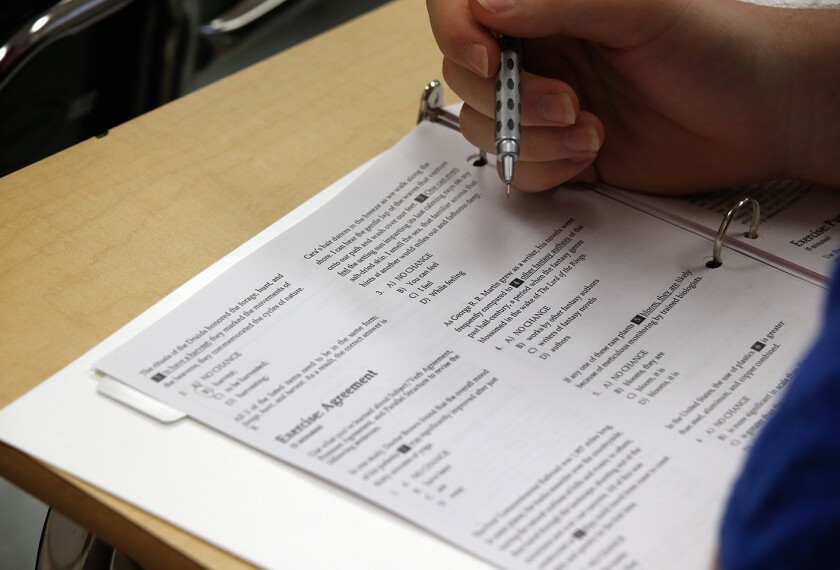Edward L. Thorndike (1874-1949)
Without the work of Edward L. Thorndike, the children in the fictional town of Lake Wobegon would not know that they are all above average. A leading psychologist based at Teachers College, Columbia University, for the first half of the century, Thorndike was the originator of a scale of achievement in a wide variety of subjects. Educators could then compare their students’ performance against the average achievement--commonly called the norm--of a representative sample of children.
The work of Thorndike and his graduate students from 1908 to 1916 established norms for arithmetic, reading, handwriting, and other subjects, according to a history of educational testing published by the National Academy of Sciences in 1982. Thorndike’s work focused mostly on handwriting because he believed that its style, beauty, and uniformity revealed as much about test-takers’ intelligence and character as did content knowledge in other subjects. The norms established by Thorndike gave school administrators their first chance to compare the knowledge and abilities of their students against an average.
Today, all major national tests--from standardized tests available at all grade levels to the SAT college-entrance exam--compare individual test-takers and groups of students against such norms. Thorndike went on to work with Robert M. Yerkes, Lewis M. Terman, and other leading psychologists in developing the famed Alpha-Beta tests for the U.S. Army during World War I. After the war, the three of them were part of the group that created the National Intelligence Tests. Within a few years of its introduction, school officials relied on that test’s results when assigning students to academic tracks.
Lewis M. Terman (1877-1956)
pioneer in the development of intelligence and achievement tests, Lewis M. Terman also was one of the first to use the instruments for longitudinal research. The Stanford University professor tracked the test scores and a variety of other data--such as physical measurements and medical records--of 1,470 gifted schoolchildren in the early 1920s. Terman and his research team collected more than 100 pages of data on each subject, whose IQs ranged from 135 to 200. The researchers concluded that gifted children performed two to three grade levels higher than their peers and that they scored about the same distance ahead on tests designed to measure character traits.
Perhaps the most important finding dispelled the belief that smart children were “one-sided and neurotic,’' Henry L. Minton writes in Lewis M. Terman: Pioneer in Psychological Testing. “It suggested that gifted children had the kinds of well-rounded personalities and skills that ... could be harnessed for leadership roles in Terman’s meritocratic society,’' Minton notes in his 1988 book.
Terman pursued the subjects of his original study of gifted children, surveying them again in 1936, 1940, 1945, and 1952. In those follow-ups, he found that the gifted students continued to excel in school and throughout their careers, with the students who scored higher than 170 on the IQ test achieving the most success, Minton writes. In the final volume of the research, published in 1959, the subjects--by then in their 40s--continued to be successful in their careers and were as healthy emotionally as their peers who scored lower on IQ tests.
Terman used IQ tests to investigate the link between intelligence and heredity. In 1929, one of his Stanford students completed a dissertation suggesting that children’s intelligence was not influenced by their environment. Even though it was disputed by simultaneous research conducted at the University of Chicago, Terman continued to believe there was a genetic link to intelligence, Minton notes. Until 1935, Terman was active in the racially charged eugenics movement, which advocated the propagation of individuals who were deemed to be genetically superior.
Robert M. Yerkes (1876-1956)
Since the start of intelligence testing, scores have often been used to support existing stereotypes. Perhaps no research has been cited as doing so more than Robert M. Yerkes’ analysis of tests given to World War I soldiers.
The Johns Hopkins University psychologist led a team of his peers on the Committee on the Psychological Examining of Recruits. The team created the Alpha-Beta tests to gauge the intelligence of young men. (The Alpha assessed the literate recruits; the Beta tested the illiterate.)
In 1921, Yerkes edited a volume analyzing the results. The data suggested that black men as well as Southern and Eastern Europeans scored the worst. Even though the report called for a cautious interpretation of the results, policymakers in the United States cited them in 1921 and 1924 as reason for restricting immigration from such countries as Russia, Italy, and Poland. Educators also pointed to the scores as justification for the belief that African-Americans were intellectually inferior because of their ancestry. “The seeds of prejudice were deeply embedded in American culture ... and the new science of testing seemed to provide them a medium within which they could grow,’' Robert M.W. Travers writes in his 1983 history of the impact of research on schools.
It wasn’t until the 1930s that other research disputed the findings in Yerkes’ 1921 book, according to Travers. Few of the immigrants knew English when they took the test, and the average African-American in the South attended schools only about half the amount of time that white students did. Such disadvantages, the later research said, were bound to lower their scores.



